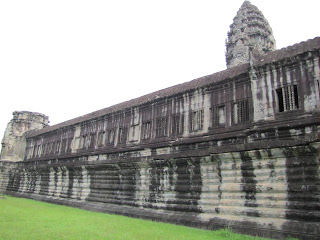"Mate, you have to go to Asia. You're half way there already."
In my five months in Australia, I was recommended by so many people to travel to Asia; and after my last class was finished in Sydney, I packed my bags and flew to Bangkok.
Cambodia was never on my itinerary, but after watching a
Documentary on youtube about the wonders of Angkor Wat, I was hooked on following in the footsteps of my childhood tomb raiding adventure's - Indiana Jones and Laura Croft.
The city of Siem Reap was my destination. I entered Cambodia from Thailand on the 27th of June, 2011, through the corrupt and dodgy boarder town of Poipet, where our bus company tried to scam me and fellow travelers on our Cambodian visa's.
 |
| Poipet |
During this ordeal I made friends with a Japanese born, Australian girl named Kaori Hanazawa. The next day we shared the price of a Tuk Tuk ride around the temples. Our first stop was the renown religious temple - largest in the world - Angkor Wat.
View Larger Map
 |
| Ancient moat surrounding Angkor |
 |
| Walkway to Angkar, past moat |
 |
| Angkor at sunrise, about 5:30 AM |
Angkor Wat - meaning 'temple that is a city' - was constructed in the 11th century as a Hindu Temple to Vishnu and tomb for king Suryavarman the second. It's symmetry, carvings and shear size make it an awe inspiring place to visit.
 |
| Kaori and I in front of Angkor |
The layout of Angkor is as follows: symmetrical squares descending in length but rising in height until the central temple.
The outer layer is a large moat, which is surrounded by a wall. Inside the wall are various pools and small wats set symmetrically around the central complex. The central temple is surrounded by an Esplanade covered in drawings and Bas-reliefs, followed by another, higher raised outcropping before the final grand climb to the central temple - the heart of Angkor Wat.
 |
| Outer moat |
 |
| Outer Wall |
 |
| Esplanade |
Once inside the esplanade, the engravings on the walls became more elaborate; dancing apsaras(over 3000 carved throughout the complex) adorned the facades, and along the outer corridors, bas-reliefs of ancient battles and Hindu epics lined the walls.
 |
| Apsaras |
 |
| Bas-Reliefs |
|
After walking around the esplanade admiring the bas-reliefs, we came upon looming stairs which brought us up to the second to last layer of Angkor.
 |
| Should have rented the balloon! |
Inside this section of Angkor were various decapitated statues. Later, at the national museum in Phnom Penh, I discovered that many of the statues that were once in Angkor were removed and hidden from the Khmer Rough, who destroyed thousands of statues and ancient religious sites in the 1970's.
Finally, past section after section of beautiful carvings and giant staircases, we reached the central complex of Angkor Wat.
And after scaling the stairs we entered the center of Angkor: a space of four outer towers connected to a central, taller tower with shrines and Buddhas on each of its four corners. I felt a strange sensation from up here, some type of unseen spiritual force that came from being at the heart of this giant and ancient temple. It was an amazing place to be.
 |
| Spiritual heart of Angkor |
 |
| Inside 1 of 4 entrances to central tower |
 |
| Inside 2 of 4 entrances to central tower |
 |
| Standing near the stairs to the central complex |























